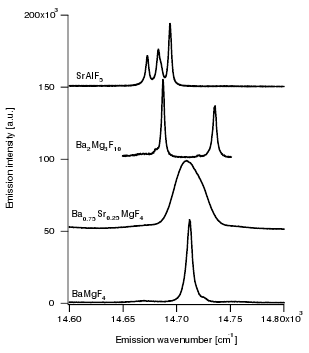-
Temperature and Host dependence of the transition interference between f-f and f-d transitions of Sm2+ in matlockites
P. Pal, H. Hagemann, H. Bill and J. Zhang
Journal of Luminescence, 161 (2015), p323-329


DOI:10.1016/j.jlumin.2015.01.030 | unige:46833 | Abstract | Article HTML | Article PDF | Supporting Info

The absorption spectra of Sm2+ doped in MFX (M=Sr, Ba; X=Cl, Br) crystals were studied within the range of 20,000‚Äď35,000 cm‚ąí1 as a function of temperature and host. The absorption bands observed were described with a simple model developed by Wood and Kaiser using group theory. The temperature and host dependence on the 7F0‚Üí5D3 Fano resonance lines were investigated. BaFCl:Sm2+ system showed a ‚Äúnormal‚ÄĚ 7F0‚Üí5D3 transition at 4 K in spite of similar crystal structure and absorption profile with other MFX hosts. New Fano resonances were observed in the absorption spectra at higher energies (23,000‚Äď25,000 cm‚ąí1) for all MFX:Sm2+ systems at 4 K which persist up to room temperature. Preliminary energy level calculation showed that these resonance lines involve the interaction between higher excited 5LJ states of 4 f6configuration and 4 f55d1 configuration.



